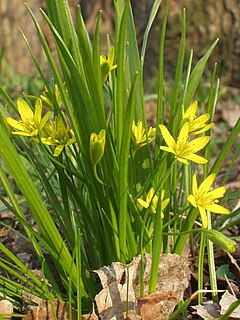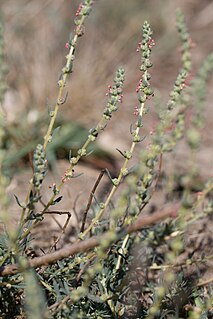
Alexander Georg von Bunge was a Russian botanist. He is best remembered for scientific expeditions into Asia and especially Siberia.

Gagea is a large genus of spring flowers in the lily family. It is found primarily in Eurasia with a few species extending into North Africa and North America.

Leymus is a genus of plants in the grass family Poaceae (Gramineae). It is widespread across Europe, Asia, and the Americas.

Eriophorum is a genus of flowering plants in the family Cyperaceae, the sedge family. They are found throughout the arctic, subarctic, and temperate portions of the Northern Hemisphere in acid bog habitats, being particularly abundant in Arctic tundra regions.

Ephedra is a genus of gymnosperm shrubs, the only extant genus in its family, Ephedraceae, and order, Ephedrales. The various species of Ephedra are widespread in many lands, native to southwestern North America, southern Europe, northern Africa, southwest and central Asia, northern China and western South America.

Leonurus is a genus of flowering plants in the family Lamiaceae. It is native to Europe and Asia, naturalized in New Zealand, Hawaii, New Caledonia, and much of North and South America.

Lagochilus is a genus of the mint family that contains Turkistan mint.

Helictotrichon, or alpine oatgrass, is a genus of perennial flowering plants in the grass family. The genus name comes from the Greek heliktos meaning twisted, and trichos meaning spine, referring to the shape of the awn.

Kobresia is a genus of plants in the sedge family. They are sometimes called bog sedges. These perennial sedges are quite similar to Carex species in appearance. The genus is widespread across much of Europe, Asia and North America, with many species native to the Himalayas.

Heteropappus is a genus of Asian flowering plants in the daisy family.
Brachanthemum is a genus of flowering plants in the aster family, Asteraceae. They are native to Asia.

Kalidium is a genus of flowering plants in the plant family Amaranthaceae. The species are shrubby halophytes distributed in Southeast Europe, Southwest Asia and Central Asia to China.

Lacydes spectabilis is a moth of the family Erebidae. It was described by August Michael Tauscher in 1806. It is found in south-eastern Ukraine, eastern European Russia, western Siberia, Kazakhstan, Central Asia, Armenia, eastern Turkey, Turkmenistan, Afghanistan, China (Xinjiang) and southern Mongolia.

Ziziphora are a genus of annual or perennial herbs or subshrubs in the family Lamiaceae. Ziziphora has aromatic leaves; they are found in open and often xeric habitats in Southern and Eastern Europe, North-West Africa and Asia to the Himalayas and Altai mountains.
Lophanthus is a genus of plants in the family Lamiaceae, first described in 1763. It is native to central and southwestern Asia from Turkey to Mongolia, with many of the species endemic to Iran.
- Lophanthus adenocladus(Bornm.) Levin - Iran
- Lophanthus allotrius(Rech.f.) A.L.Budantzev - Iran
- Lophanthus archibaldii(Rech.f.) A.L.Budantzev - Iran
- Lophanthus chinensisBenth. - Mongolia, Xinjiang, Siberia
- Lophanthus depauperatus(Benth.) Levin - Iran
- Lophanthus dschuparensis(Bornm.) Levin - Iran
- Lophanthus elegans(Lipsky) Levin - Afghanistan, Tajikistan
- Lophanthus hedgei(Freitag) A.L.Budantzev - Afghanistan
- Lophanthus iranshahrii(Rech.f.) A.L.Budantzev - Iran
- Lophanthus kryloviiLipsky - Mongolia, Xinjiang, Kazakhstan, Altai
- Lophanthus laxiflorus(Benth.) Levin - Iran
- Lophanthus michauxii(Briq.) Levin - Iran
- Lophanthus ouroumitanensis(Franch.) Kochk. & Zuckerw. - Afghanistan, Tajikistan
- Lophanthus oxyodontus(Boiss.) Levin - Iran
- Lophanthus pinetorum(Aitch. & Hemsl.) Levin - Afghanistan, Pakistan, western Himalayas
- Lophanthus schrenkiiLevin - Xinjiang, Kazakhstan, Kyrgyzstan
- Lophanthus schtschurowskianus(Regel) Lipsky - Kyrgyzstan, Tajikistan
- Lophanthus sessilifolius(Bunge) Levin - Iran, Pakistan
- Lophanthus subnivalisLipsky - Kyrgyzstan, Tajikistan
- Lophanthus tibeticusC.Y.Wu & Y.C.Huang - Tibet
- Lophanthus tschimganicusLipsky - Kyrgyzstan, Uzbekistan
- Lophanthus turcicusDirmenci, Yıldız & Hedge - Turkey
- Lophanthus varzobicusKochk. - Tajikistan
Panzerina is a genus of plants in the Lamiaceae first described in 1982. It contains 2 known species, native to Siberia, China, and Mongolia.
Anti-Mongolian sentiment has been prevalent throughout history, often perceiving the Mongols to be a barbaric and uncivilized people.
Rhinactinidia is a genus of Asian plants in the aster tribe within the sunflower family.

Camphorosma is a genus of flowering plants in the family Amaranthaceae, found in northern Africa, southern and eastern Europe, Crimea, Russia, Anatolia, the Caucasus, Iran, Afghanistan, Pakistan, Central Asia, the Altai, western Siberia, Xinjiang in China, and Mongolia. Annuals or subshrubs, they can be distinguished from closely related taxa such as Bassia by their flattened perianths which have four lobes, inflorescences with multicellular glandular hairs, a distinct C4 leaf anatomy type (called the Camphorosma type), and a chromosome count of 2n = 12.
Betula gmelinii is a species of birch native to the Altai, Siberia, Mongolia, northeastern China, the Korean peninsula and Hokkaido in Japan. It prefers to live in sandy soils. Its 'Mount Apoi' cultivar has gained the Royal Horticultural Society's Award of Garden Merit.













